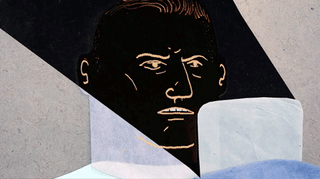World Cup, 1998. France versus Brazil. That was my introduction to the world of football—it was the summer before high school started. Fear and anxiety reigned over the fans supporting their respective teams, their pride and glory. Both sides bit their nails, covered their eyes, and cheered unabashedly loud. Brazil seemed unstoppable coming into the tournament, but France had home advantage in a packed Stade de France.
July 12th, 1998, will forever be engraved in the mind of millions of French fans as the day they touched gold for the first time—the day Zinedine Zidane was forever immortalized. Moments like that are what drives NYC-based artist Case Jernigan to create animated paper cut out masterpieces, inspired by his passion for the world of soccer.

Case Jernigan’s academic background in classical painting and ancient history lend greatly to his well-rounded talents as an artist that works in an intersection between storytelling, drawing, paper cutout artwork, and animation. He often revisits subjects like European football, as well as some recent political work, and has had his hands full with commissioned pieces by the likes of The New York Times, adidas, as well as many known Football Clubs throughout the country.
Inside his small art studio loft apartment in New York, Case has been able to immortalize some of the most memorable moments in football history, and more recent work with zombies (which we at The Hundreds are fascinated by). I caught up with him to discuss how he “grew up” from painting to find his true form of expression, and how he came into his own as an artist with a conservative background disconnected from art.
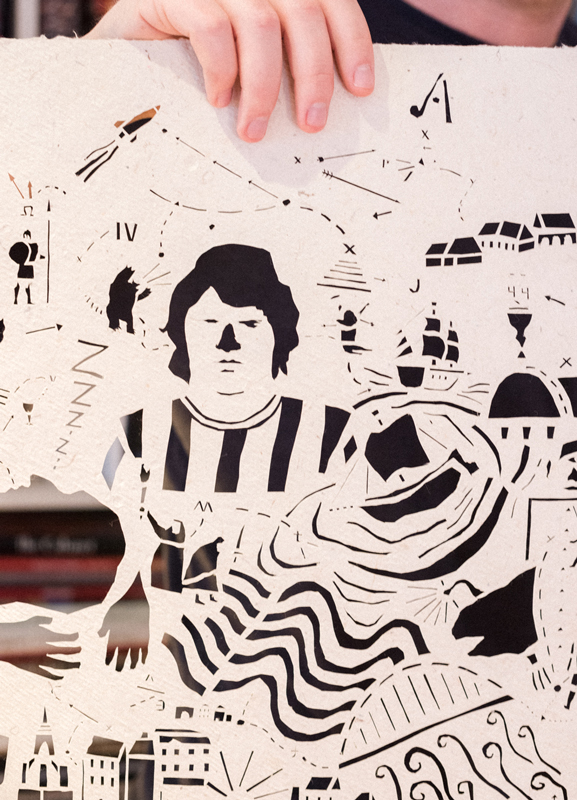
Case Jernigan with a paper cutout.
JOHNNY F. KIM: Who you are and what do you do?
CASE JERNIGAN: I grew up in Charleston, South Carolina. We moved a lot, so I lived in a house by the dunes and ocean, and then another next to oak trees sprouting from the cobblestones. I remember the funky smell of the marsh sometimes. I admired a local painter and took life drawing lessons in a creaky Victorian building downtown. Times change, and Sean Brock bought my art school and turned it into a popular restaurant. Charleston casts a spell on its residents though; people there don’t understand why anyone would leave. But I had to go, so I’m slowly becoming a New Yorker. I’ve been here since 2010 and I draw, cut paper, and animate. I make artwork every day, for myself and for clients, in a small art studio loft in my apartment.
How was your career path led you to what you do right now?
I studied painting and ancient history in college without thinking about the future. Senior year, I realized my friends had jobs lined up while I was clueless. I didn’t know any artists that weren’t academics. I was raised in a very conservative place, so the idea of just becoming an artist out of personal necessity seemed foreign, maybe even selfish. So I turned my thoughts to teaching and managed to land a job at a boys’ boarding school in Connecticut. I coached tennis and squash, taught art history and tutored, and lived on the dorm as a monitor. This time enriched me forever, but the art I made lacked urgency.
From “See/Saw”
“I was raised in a very conservative place, so the idea of just becoming an artist out of personal necessity seemed foreign.”
I quit after two years and enrolled at the New York Studio School. I fashioned myself a classical type of oil painter with New York and Abstract Expressionist influences. I obsessed over DeKooning, Davinci, and early Picasso. I made some decent paintings, but mostly featureless works with no identity. I finished school and flopped around on my own for awhile in a shared studio space, and then a bigger space in Brooklyn with no heat or insulation. In winter, the cold air filtered straight through holes in the brick and I wore my parka while painting. I began cutting paper and spending more time with drawing materials. I managed to let go of the stigma that painting needed to be my true form of expression. In short, I grew up. I knew deep down that I would never be any good unless I spent more hours in the studio. I was working two part time jobs—I quit one of them. Times were lean, but my wife is the best. Her encouragement, patience, and belief served as serious motivation to be better. Also fear—the fear of being mediocre, of looking back and feeling regret.
Many of us know you through your work that you have done around football culture. How and why did you decide to make football your main subject?
Well, I don’t think football is my main subject, but the game remains hugely important to me. I liked soccer as a kid… and got sucked into the 2006 World Cup as I was traveling through Germany and Italy. I rekindled an old interest in the US Men’s Team and Newcastle United and my love for the game grew from there. Before the 2014 World Cup, nostalgia from my previous travels crept into my life. Now I can look back and see [that] much of the soccer art at that time felt one-dimensional or completely of the moment. My interest has always gone deeper—to the feelings I had seeing Alexi Lalas and that stars and stripes kit, the Sambas and umbro shorts that were my uniform for so many years… Soccer became a large part of my existence through the years, and artistically, the material sat right in front of my face: the iconic nature of Valderrama’s hair, the deep black and white of the boots in the ’90s, the drama of the commentators, and the glory of watching your team play well.
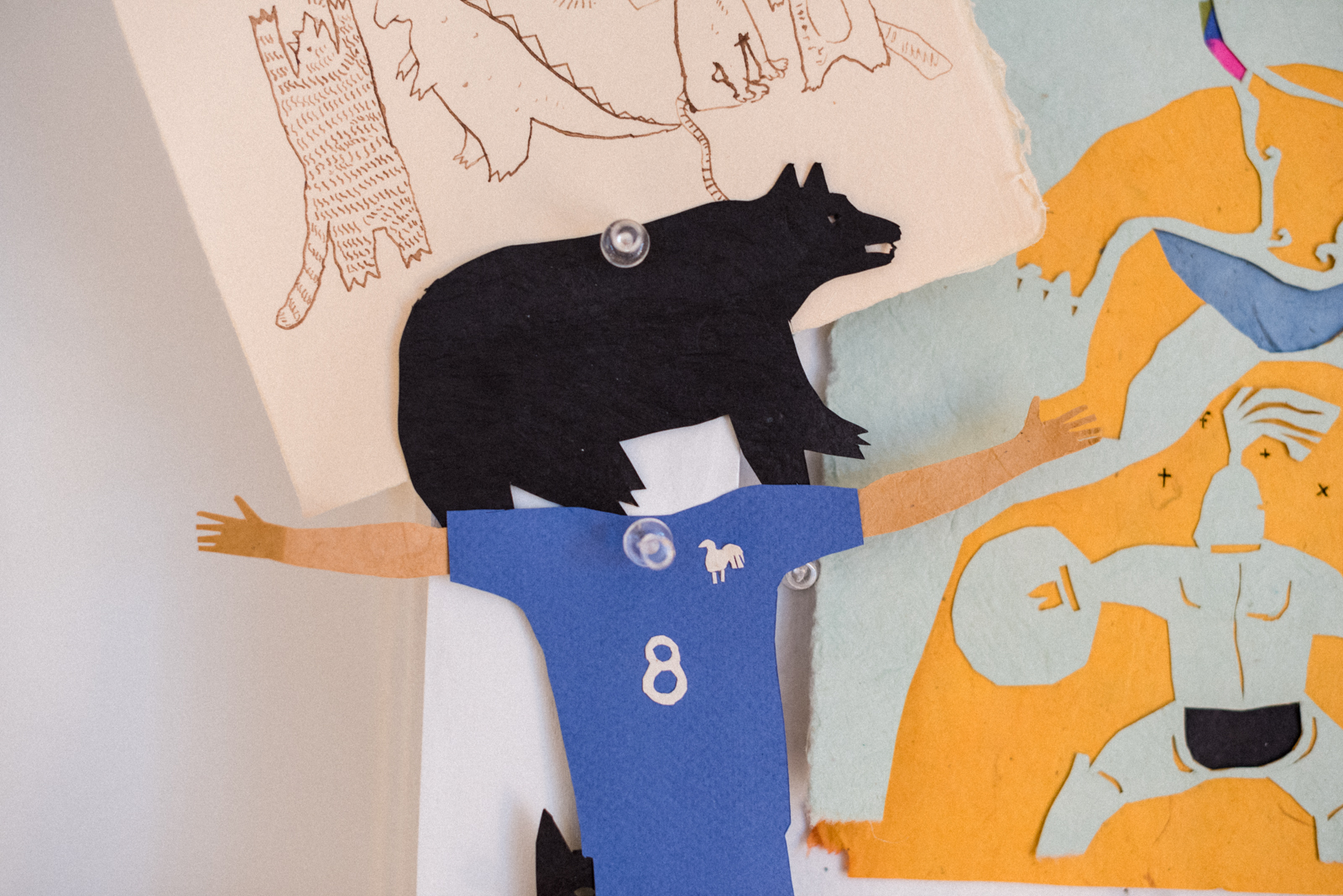
“I managed to let go of the stigma that painting needed to be my true form of expression. In short, I grew up.”
What is your process like? How do you choose which format to work with—does it start off as a classic pencil and paper doodle?
I always return to pencil, ink, and paper. Drawing generates momentum and fleshes out ideas. Drawing can be a focus or preparatory exercise, or a means of art making in itself. Paper cutting and animating often feel like craft to me, whilst painting feels the most poetic. But that poetry can often become self-indulgent in my hands. Drawing always feels right and good, and often I take what I’ve drawn and convert it into something else—be it a cutout, a series of quick shot animations that I can loop, or a backspace to overlay animation on top.
How long does it take you to make each piece, especially the animation?
I work rapidly, but animation takes shape over long periods of time. I usually get sucked into short animations I’m working on and commit myself to them full time. With that approach, it may take a month or more to finish up a minute of animation. Drawings and paper cutouts emerge faster. Usually the slow part is figuring out new languages or ways of representing an object, figure, etc.—but once you’ve cracked the code, it can be translated into new works. It’s like finding symbols and being able to use various versions of them across mediums. I like stacking, collecting, positive buildup. In many ways, my artwork is about accumulation.
The Story of Euro 2016, commissioned by The Guardian, featuring a blend of animation from illustrations and, paper cutouts.
Your work is more hands-on vs. digital. Some people would rather take the computer short cut when it comes to doing things. You’ve said in the past that your method is the most personal thing an artist can do.
I like texture—the fibers of paper, the feel of graphite or charcoal rubbing across a surface, the tension and pull of canvas stretching and stapling into wood, the flush of ink as it touches a wet spot of paper. I try to push as much of that feeling into my animation as I can. When I study artworks, like Pieter Bruegel’s “The Harvesters” in the Met, I study layers and textures. There are tiny graphite lines of preparatory drawing underneath the paint, and touches of heavy green on the leaves. Through texture and layers, one can feel the action of the artist and not just the result. Our society feels incredibly image-obsessed at the moment—momentary flashes of color and text that satiate us for a brief second. I prefer to think about layering; I like to slow down and really look at the art I love.
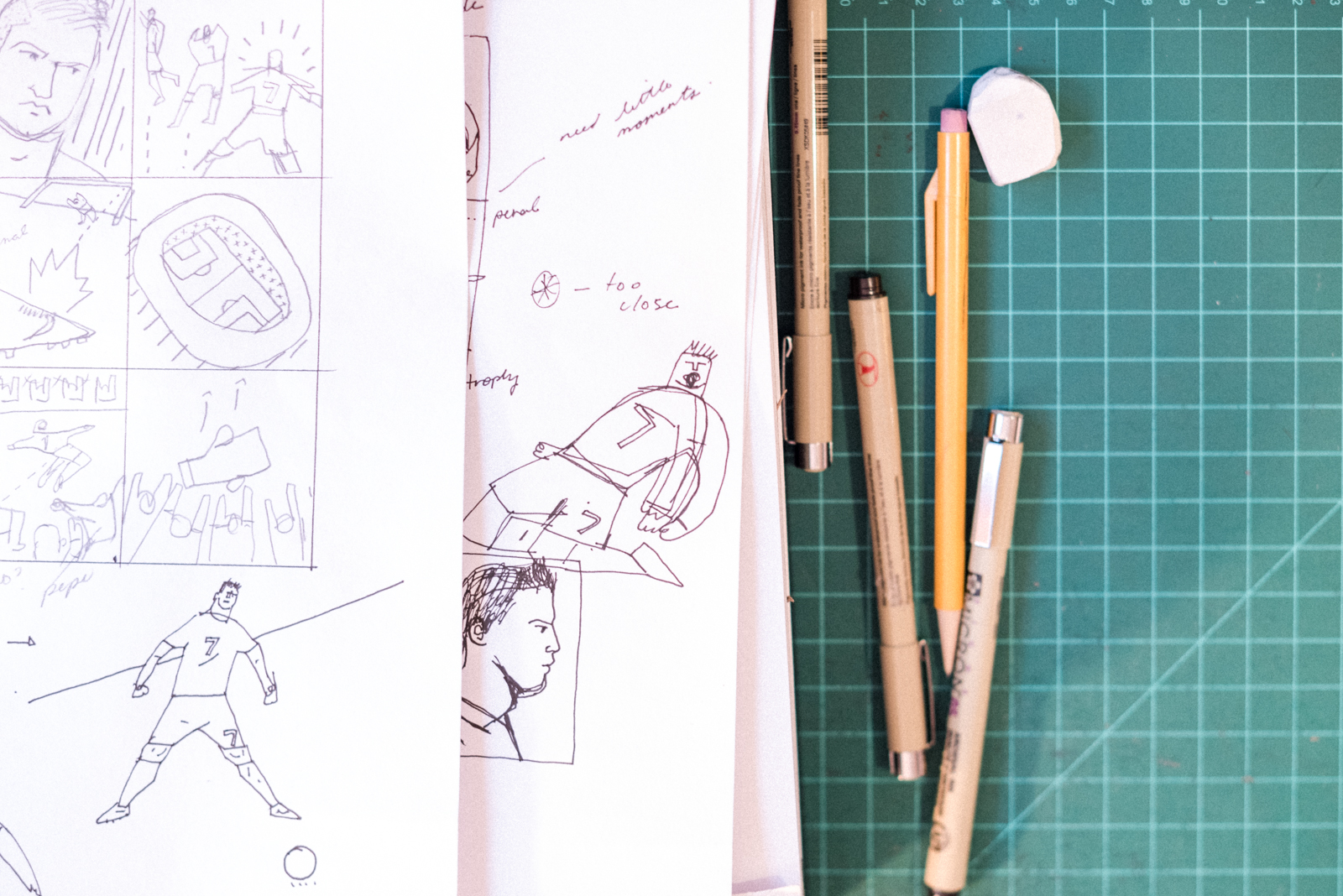
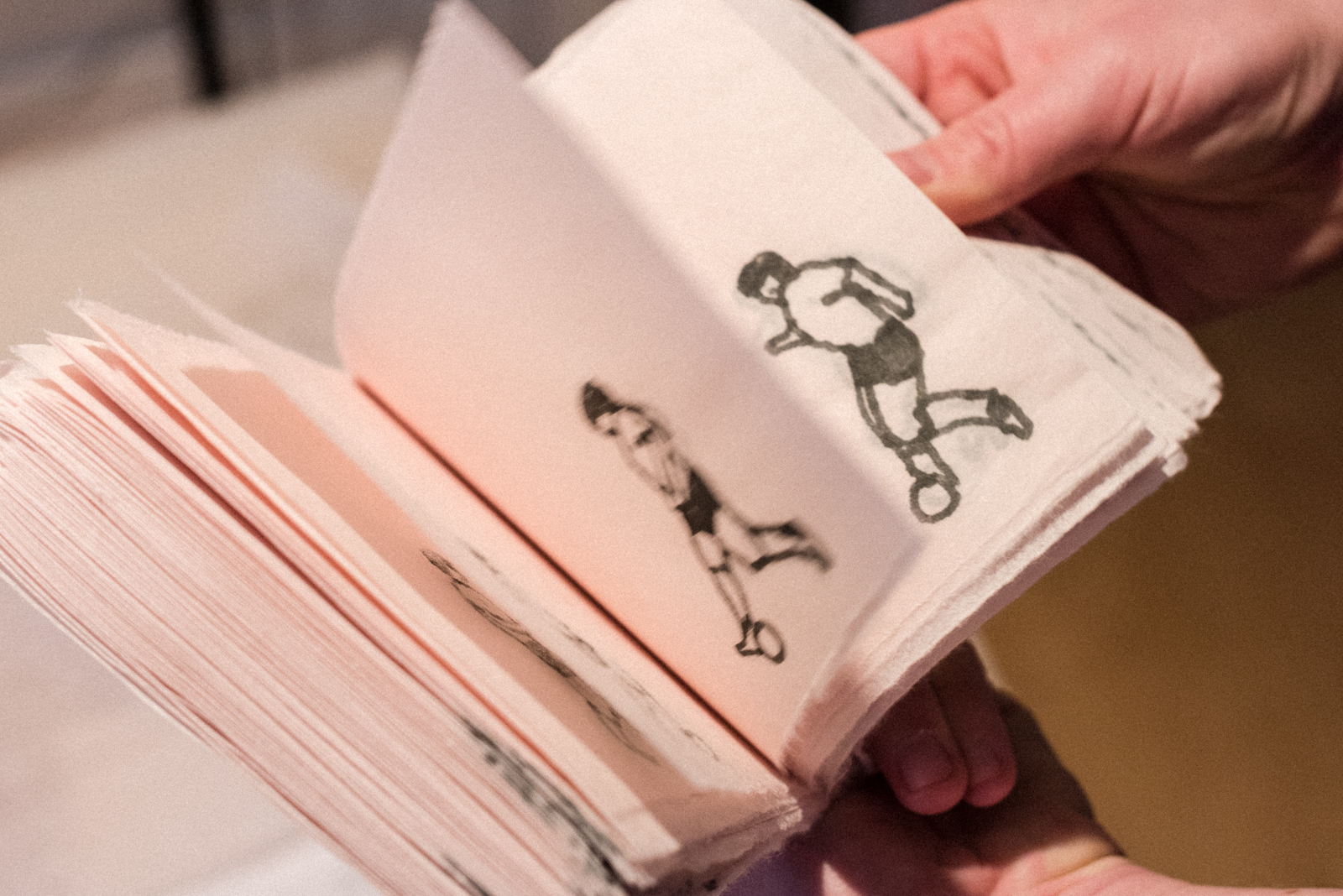
You immortalize moments in football that are so important to its history. Are football players immortal?
It’s such a core part of human nature to desire a legacy. When we die and the world turns, what do we leave behind? When I’m approaching the end, I hope I can say that my work touched or affected people. Athletes have the opportunity to do this on a regular basis and on an unprecedented scale.
We know you mostly for the soccer-themed work, but you also have different styles and themes you explore.
Lately I’ve been making light boxes. I craft wood boxes and staple fabric or canvas over the front like a painting. I sew my cutout artworks over the canvas and plant LED lights behind. The negative space shines out strongly, like a painting, while the textured paper bits stay dark. Thematically, I’ve always been interested in mythology, and those themes occur in my cutouts and drawings. I mounted an exhibition in Charleston last year of little soldiers, Trojan horses, buried artifacts, Cyclopses, and many oared boats heading to sea. At the moment, current political changes are influencing my imagery. I’m making loads of Batman portraits, cities under the threat of the apocalypse, and zombies.
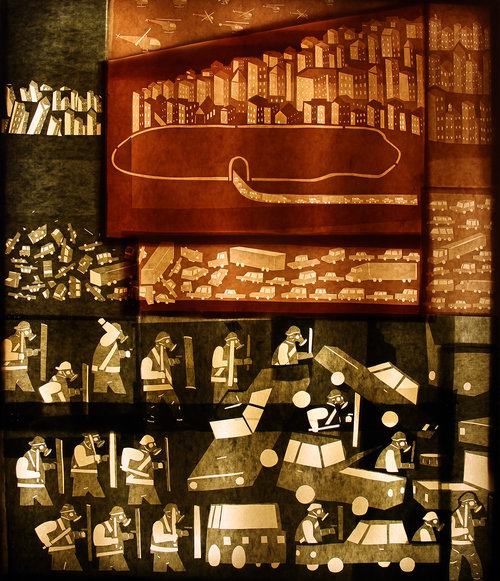
A Case Jernigan light box piece.
From your drawings to your cutouts, your work seems to contain some political messages. How has the recent state of U.S. politics inspired you?
Definitely. Trump’s ascendancy and global politics, like Brexit, have sent me down a dark path. I start making light box cities, and before I know it, I’ve piled up crashed cars or made zombie hordes. I’ve cutout and drawn Batman portraits for a year or two, but suddenly he’s hurling people off roofs or even punching Trump directly in the face. In many ways, all of my work relates to childhood. My household was super religious—we went to church sometimes twice a week, and I was an altar boy every Sunday. My town was not diverse. It wasn’t until college that I started to question and view my quite particular upbringing with a more critical eye. That struggle, between the bubble I was raised in and the life I lead now, comes out in the work. I’m grateful for that, but it’s also strange. I’m a completely different man as a 31-year-old then I was as a boy. But I still like all of the same things. I draw, play sports, play video games, and read comic books. This was the exact structure of my youth. Hopefully, my wife will say I’m more emotionally intelligent than I was years ago, but I need to keep connecting with the early memories and nostalgia to make good work.
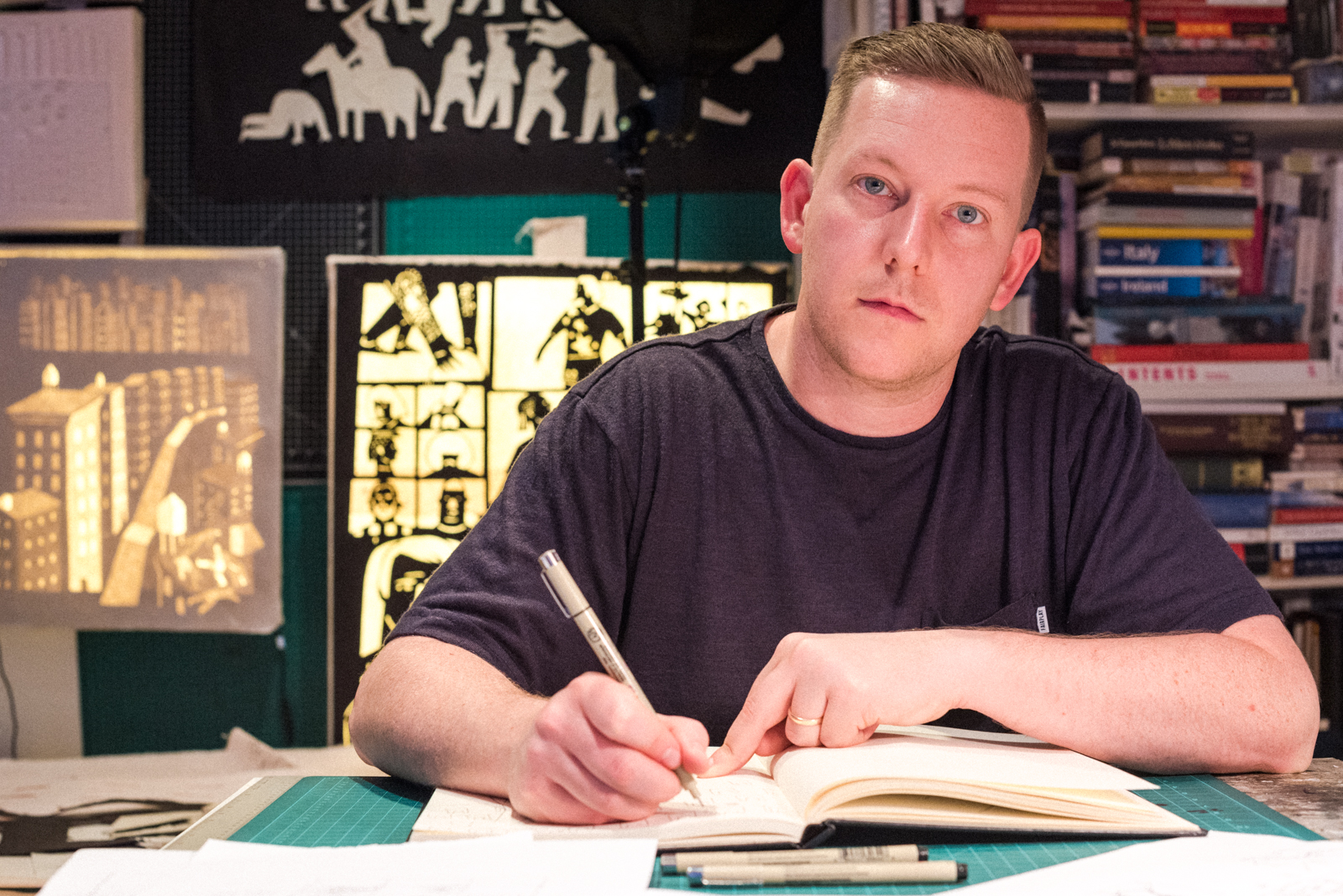
***
Follow Case at casepaint.com and @wcjern on Instagram.

